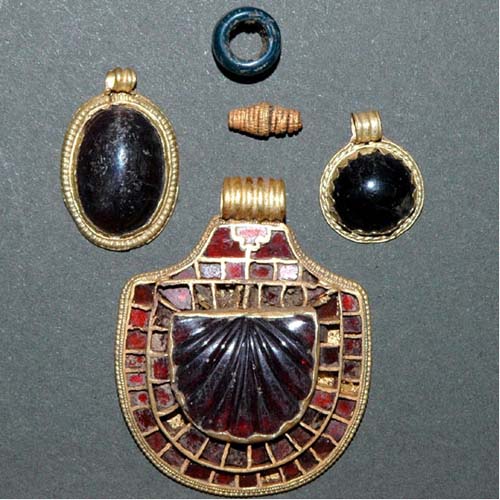Burial practice reveals Anglo-Saxon beliefs
An English archaeologist recently excavated the land in Yorkshire, England. According to him, in the 7th century in England, the body of a woman - adorned with jewels - was placed on a specially designed bed and buried in a tomb located at the center of the Anglo cemetery -Saxon.
This woman's jewelry (including a large shield-shaped pendant), the shape and location of the cemetery as well as excavated weapons, such as a knife and a langseax (an Anglo sword) -Saxon sharpened on one side) quite beautiful, making scientists believe that she could be a member of the royal family, the head of a religion outside Christianity when Christianity was just beginning to take root in this region.
According to archaeologist Stephen Sherlock, who runs the project, ' I believe it is a kind of religion based on the placement of graves, the short shelf life of the cemetery, of the bed and of The grave - almost at the center of a common cemetery. The center point of the cemetery is based on the location of the bed - in our view this place is erected and other graves are dug around it. '

Jewelry of religious heads?
In the land of Yorkshire, England, the body of a woman - adorned with jewels - is placed on a specially designed bed and buried in a grave located at the center of the Anglo cemetery - Saxon. This is one of the jewels discovered at the mourning bed. (Photo by Stephen Sherlock, Mike Pitts)
Sherlock collaborates with Teesside Archaeological Community, which has just released a report on the study. The summary of this discovery also appears in the latest edition of British Archeology.
The cemetery is named Street House, consisting of 109 graves.Most tombs are dug into a square around the bed position . Sherlock said, 'This square diagram is an unprecedented thing in Anglo-Saxon England.' The ruins of a subsided building, perhaps a funeral chapel to put the body before a funeral, are located near the entrance of the cemetery. A makeshift and grave is also within the square.
Funeral bed consists of a wooden bed fixed and decorated with iron. The artifacts inside the tomb include two gem pendants, gold and glass beads, beads or brooches with magical beads, and a shield-shaped pendant that according to Sherlock and his partner Mark Simmons is quite unique. original compared to the time.
Centrally located is a blue gemstone, surrounded by 11 lobes carved in a shell shape and a lower outer shell shaped like a shell. The red gems are on yellow leaves, capable of reflecting light around the central stone when worn.

Central location
Diagram of the cemetery. Funeral bed is placed in the central position of the rectangle. Scholars believe that the central position of the mourning bed shows that the person lying there can once head a religion. (Photo by Stephen Sherlock, Mike Pitts)
Although acidic soil corroded the woman's body, the age of the cemetery and its location provided a clue to her identity. Sherlock believes that the most notable person is Ethelburga, the wife of King Edwin of Northumbria , who converted to Christianity and was canonized. Other names are Eanflaed, King Oswiu's wife or Aelflaed, Oswiu's daughter.
Next to the mourning bed is a grave that also contains precious jewels, such as a unique gold pendant, a silver cloak and glass beads. The woman in that grave could be a relative or a maid, while researchers believe other tombs may have entourage or followers. Iron-era coins, pierced to hang, discovered in one of the outer tombs, showed that at least one member of this group was interested in Christianity.
Archaeologist Mike Pitts, British Archeology editor and former manager of the Alexander Keiller Museum at Avebury, told Discovery News ' This site dates from an interesting period in European history. Europe, when many religions and beliefs coexisted. Among them, Christianity eventually rose to religious, social and political domination. '
In 657, the same time the cemetery was built, a nearby monastery was built, marking 'a turning point in Christian history in England .'
'So Street House cemetery is particularly attractive. It seems to turn around, literally, a woman. Her funeral bed is a kind of pagan type, a rare type of female equivalent to a tangled boat, like she was placed on a kind of vehicle that could take her to the afterlife. '
Sherlock and archaeological team are expected to investigate the Yorkshire area further this year. They hope to find a link between the Anglo-Saxon neighborhood and the cemetery.
- Anglo-Saxon women are buried with luxury jewelry
- He discovered an ancient tomb that was strangely buried
- Discover the biggest treasure in the UK
- Test AND and the secret of Viking empire
- Found 1,100-year-old Anglo Saxon coins and long Pict houses
- You: Discover new treasure from the Anglo-Saxon era
- Poor falling into the sky suddenly changed into a millionaire by finding out this one no one uses
- Alfred Dai's remains
- You used to have 'Apartheid regime'.
- The goal is that few people know of burial on trees
- 'Eco-friendly' burial is becoming a trend!
- Unusual burial practices in Tibet
 Discovered an ancient centipede fossil 99 million years old
Discovered an ancient centipede fossil 99 million years old Discovered bat-like dinosaurs in China
Discovered bat-like dinosaurs in China Discovered a 200-year-old bronze cannon of the coast
Discovered a 200-year-old bronze cannon of the coast Discover 305 million-year-old spider fossils
Discover 305 million-year-old spider fossils